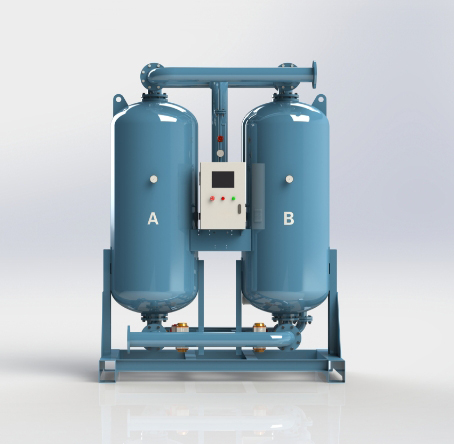During the operation of air dryers (such as compressed air adsorption dryers), adsorbent powdering—commonly affecting materials like activated alumina and molecular sieves—is a critical issue that should not be overlooked.
I. Main Causes of Adsorbent Powdering
-
Mechanical Wear and Airflow Impact
Excessive airflow velocity (beyond design limits) can cause particle collisions and friction against the vessel wall, leading to mechanical wear. -
Frequent Switching
Rapid pressure fluctuations during adsorption/regeneration switching (e.g., due to fast valve action) can generate strong air shocks that damage the adsorbents. -
Adsorbent Quality Issues
Low mechanical strength (e.g., inferior or expired adsorbents), poor particle uniformity, or insufficient compressive strength can all contribute. Long-term use may also lead to aging and structural weakening. -
Improper Operating Conditions and Pressure Fluctuations
Frequent compressor start-stop cycles can cause repeated expansion/compression of the adsorption bed. -
Excessive Temperature
Regeneration temperatures exceeding the adsorbent’s tolerance can cause degradation. -
Moisture or Oil Contamination
The presence of oil or liquid water in compressed air can lead to caking and subsequent disintegration of the adsorbent. -
Design Flaws
Poor height-to-diameter ratio of the adsorption tower, uneven airflow distribution (e.g., excessive velocity at the bottom), lack of buffer layers or distributors can lead to direct impact on the adsorbent.
II. Consequences of Powdering
-
Reduced Drying Efficiency
Powdering reduces the effective surface area, diminishing adsorption capacity. -
System Blockages
Fine particles can travel downstream, clogging pipelines, filters, and other equipment. -
Valve Malfunctions
Accumulated powder on valve sealing surfaces can cause leakage or failure. -
Increased Energy Consumption
Higher pressure drop results in increased energy demand to maintain operation.
III. Solutions
-
Optimize Operating Parameters
Control airflow velocity, adjust regeneration temperature and duration, and avoid excessive switching. Ensure effective pre-treatment (oil and water removal) to prevent contamination. -
Replace or Supplement Adsorbents
Use high-strength, wear-resistant adsorbents. In cases of severe powdering, replace the entire bed and clean out residual powder. Add inert alumina balls as a support layer to protect the bottom adsorbent. -
Equipment Maintenance and Upgrades
Inspect and, if needed, replace the airflow distributor. Install high-efficiency filters at the tower outlet to trap fine particles. Optimize valve switching logic to reduce pressure shocks (e.g., by increasing switching time). -
Regular Inspection
Open the tower for internal inspection at least once a year. Monitor pressure drop—abnormal increases may indicate early-stage powdering.
IV. Preventive Measures
-
Airflow Distribution Testing During Commissioning
Ensure even flow throughout the bed. -
Procurement Standards
Require suppliers to provide data on compressive strength, abrasion resistance, etc. -
Operator Training
Prevent abrupt changes in pressure or temperature due to manual operations.
If powdering persists, it is recommended to consult the equipment manufacturer or a professional service provider for a comprehensive system diagnosis to rule out design or selection issues.
JOOZEO’s technical team offers high-quality adsorbents and remote diagnostic services to help customers optimize their working conditions, ensuring the best performance and longer service life of their systems.
Post time: Apr-17-2025


